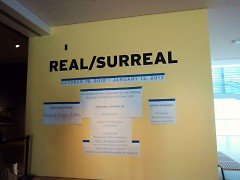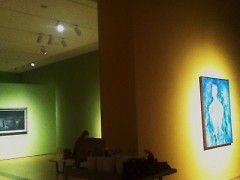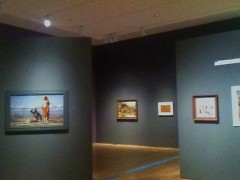The Grand Rapids Art Museum’s (GRAM) upcoming show, Real/Surreal explores the existing tension between artistic realism and the manipulation of reality represented in the work of surreal and abstract artists. The exhibit showcases work in America during the 30s, 40s and 50s, all of which covers a wide range of locations and subject matters. The focus hones in on the tension between real and surreal by juxtaposing the two kinds of work throughout the show. It lines them up for comparison and as complements to each other, while illustrating the areas in which the two techniques overlap.
The realist artists featured in the exhibit set out to depict the world as they saw it, their representations reflecting the world in front of them. The surrealists, alternatively, allowed themselves to deviate artistically from the concrete world they were representing. Their work ranges from subtle changes to warping the entire image, turning it into the abstract. In abstract works the original subject is only recognizable in the most minimal sense, if at all. These works are generally more open to the viewer’s and artist’s interpretation than works that contain realistic representations.
Another show, exhibiting Salvador Dali’s Twelve Tribes of Israel will be also at the GRAM in conjunction with Real/Surreal. This addition is meant to demonstrate a well-known European intervention into Surrealism, intended to complement the many North American artists included in the main exhibition.
The exhibit will be split into five separate themes: Alone in a Crowd, Conjured Dreamscape, Observed Places, Questioning Faith & Innocence, and Un-Still Lives. The layout of the themes suggests an interconnecting quality between them rather than a separation. The various works are all meant to be viewed in relation to each other instead of on a strictly individual basis.
The GRAM also collaborated with the Grand Rapids Community Media Center to create an audio tour. The tour includes comments from the exhibit’s curator, Cindy Buckner, as well as commentary from Paul V. Murphy, History Professor at Grand Valley State University. Murphy and Buckner are joined by Alexander Paschka, the GRAM’s Manager of Film, Photography and New Media. It also includes original poetry from the GRAM Store Manager, Susan Coombes.
Recordings of some of the artists featured within the exhibit are also included in the audio tour. Both sides of the spectrum are represented within these recordings, which were taken from the Archives of American Art in Washington DC. The recordings feature various artists explaining their preference for their particular modes of representation, whether surreal or real. The juxtaposition of these comments almost suggests a dialogue between the artists.
The artists whose work embodies realism tended to view the surreal and the abstract as taking an artistic shortcut or sometimes, more brutally, as missing the point of creating art entirely.
“No amount of skillful invention can replace the essential element of imagination,” was Edward Hopper’s opinion of surrealism. “One of the weaknesses of abstract painting is the attempt to substitute the inventions of the intellect for a pristine imaginative conception.”
“Reality is more than what a man can dream up,” said featured painter Ivan Albright. “A man who makes a fantasy of surrealism is thinking that he can beat nature. And he can’t. Because he is a part of nature.”
Surrealist artists argue for the necessity of human intervention in realistic interpretation to make it truly relatable.
“The human thing I suppose is what really drives the artist,” says surrealist painter Philip Evergood. “It isn’t only just the historian’s interest in the social problem, or the psychologist’s interest in it. It’s the inspiration of the forms and the inspiration of the lights and the beauty of the moment, I suppose.”
With the inclusion of the quotes, the juxtaposition and complement of the real and surreal works sharing the same exhibit is underlined, adding a more human dimension to the show’s pre-existing contrast and tension.
Real/Surreal is on loan to the GRAM from the Whitney Museum of American Art in New York. This is the second exhibition the GRAM has borrowed from the Whitney. The first was the Rauschenberg exhibit, which was showcased earlier this year. The GRAM is Real/Surreal’s first stop on its national tour. It opens to the public on Friday, October 19 and will run through January 13, 2013.
The Rapidian, a program of the 501(c)3 nonprofit Community Media Center, relies on the community’s support to help cover the cost of training reporters and publishing content.
We need your help.
If each of our readers and content creators who values this community platform help support its creation and maintenance, The Rapidian can continue to educate and facilitate a conversation around issues for years to come.
Please support The Rapidian and make a contribution today.




Comments
Cannot wait for this exhibit. I love Hopper and Albright. Great article, Lauren.